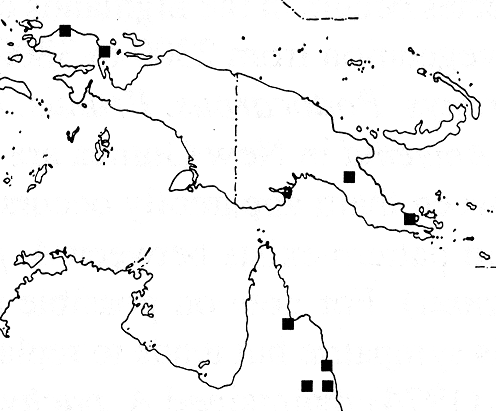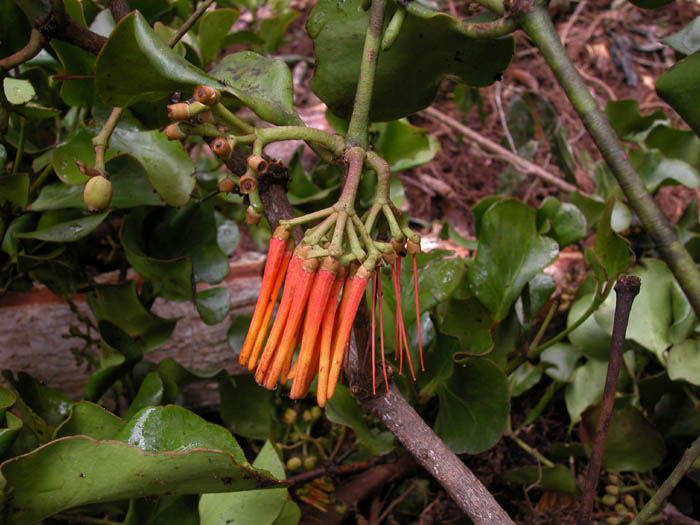
Distribution Map

Description (Barlow 1992)
Loranthus queenslandicus Blakely, Proc. Linn. Soc. New S. Wales 47 (1922) 392. - Amyema queenslandica (Blakely) Danser, Bull. Jard. Bot Buitenzorg III, 10 (1929) 298. - Type: Dixon s.n. (holo NSW), Queensland, near Herberton.
Amyema involvens Barlow, Austral. J. Bot. 22 (1974) 578.
- Type: Barlow 943 (holo AD 9701-5167; iso L, LAB), New
Guinea, Morobe, Mt Kaindi, 2440 m, l0.ii.1965.
For descriptions see Barlow, Austral. J. Bot. 22 (1974) 578; Flora of Australia 22 (1984) 94, under A. involvens andA. queenslandica. Amyema queenslandica can be identified locally by its combination of robust habit, opposite, broadly obovate, petiolate leaves, 4- to 8-rayed umbels of triads, and particularly by its dimorphic bracts, the acute central ones being erect whilst the rounded concave laterals envelop the ovary. The species has few specialized characters other than the bract dimorphy and thus presents a relatively generalized facies for the genus. Flower colour is predominantly yellow, sometimes orange or red.
The species occurs in New Guinea, in highlands from 840 to 2440
m elevation, and also in north Queensland, from sea level to 950
m (fig. 11; 26 collections seen). It occurs almost exclusively
in rain forests, parasitic on various hosts. In New Guinea it
has been recorded on Nothofagus and Timonius, and
in Australia on Canarium, Cryptocarya, Dysoxylum and Ficus.
Critical comparison of the material
of A. queenslandica from Australia and A. involvens
from New Guinea shows that there are no significant morphological
differences, and they are accordingly treated as conspecific.
Amyema queenslandica is distinctive among its Australian
congeners in its growth habit and morphology, and the Australian
populations are probably the result of relatively recent immigration
from New Guinea. The species is similar to and possibly related
to A. rigidiflora, which differs in having more rays in
the umbel and in lacking the bract dimorphism.
Description (A. involvens, from Barlow 1974)
Amyema involvens Barlow, sp. nov.
Type-New Guinea, Morobe Dist., Mt. Kaindi, 2440 m alt., Barlow 943, l0ii.1965 (AD 97015167; L; LAF).
Inflorescentiae et fibres breviter brunneo-tomentosi; cetera glabra. Caules teres, crassi, divaricatissimi, nodis incrassatis. Folia opposita; lamina ovata vel orbiculata vel spathulata, 3-5-(7) cm longa, 2 5-4-(5) cm lata, crassa, apice rotundata, basi in petiolum 5-10 cm longum attenuata vel contracta; nervatura penninerve, obscura vel costa prope basin leviter distincta. Inflorescentiae in axillis 1-3 ortae, robustae, pedunculatae, umbellatae; umbellae 4- (vel 8-) radiatae, radiis apice trifloris, fore mediano sessili lateralibus pedicellatis; pedunculus 10-20 mm longus, 1.5-2.5 mm crassus; radii 5-10 mm longi; pedicelli 3-5 mm longi, 1.5-2 mm crassi. Bracteae crassae; bractea mediana erecta, triangulare, acuta, 2-2.5 mm longa; bracteae lateralia concavae, apice rotundatae, 2-3 mm longae; calycem includentes. Calyx cupiformis, 3 mm longus; limbus integer vel irregulariter fissilis, 1 mm longus. Corolla in alabastro maturo c. 30 mm longa, 5- vel 6-mera; petala apice intus calcari deflexo vel caespes pylorum omnia praeditae. Antherae 3 mm longae, pars liberae filamentae aequans.
Glabrous except for the inflorescence and flowers shortly brown-tomentose. Stems thick, terete, enlarged at the nodes, much-branched. Leaves opposite; petiole 5-10 mm long; lamina ovate to orbicular or spathulate, thick, 3-5-(7) by 2.5-4-(5) cm, con-tracted or attenuate at the base, rounded at the apex; venation pennate, obscure or with the midrib slightly prominent near the base. Inflorescences 1-3 in the axils, robust; peduncle 10-20 mm long, 1.5-2.5 mm thick; rays usually about 4 (rarely 8), 5-10 mm long; pedicels of the lateral flowers of the triads 3-5 mm long, 1.5-2 mm thick; bracts thick; central bract of the triad erect, triangular, acute, 2-2.5 mm long; lateral bracts concave, rounded at the apex, 2-3 mm long, enclosing the calyx.
Calyx barrel-shaped, 3 mm long; limb entire or irregularly split, 1 mm long. Corolla in the mature bud c. 30 mm long; petals in the open flower S or 6, each with a defiexed spur or tuft of hairs inside at the apex. Anthers 3 mm long, about equal to the free parts of the filaments. Chrornosome Nurnber.- 2n = 18 (erroneously given as n = 18 under Amyema sp. in Barlow and Wiens 1971). Voucher: Barlow 943, see below.
Occurrence. New Guinea, from the Vogelkop, West Irian, to Milne Bay, Papua (Fig. 6), 840 to 2440 m altitude.
Specimens Examined. WEST IRIAN: Vogelkop Peninsula, Tamrau Ra., Ije R. valley, 840 m alt., van Rayen and Sleumer 7739, 7.xi.1961 (L). EASTERN NEW GUINEA: Lake Trist, Morobe Dist., 1600 m alt., Henty NGF 29137, 26.xi.1966 (LAE); N. slopes, Mt. Dayman, Maneau Ra., Milne Bay, Brass 22599, 28.v.1953 (CANB).
Although known from only four widely separated localities, Amyema involvens is relatively uniform morphologically. The species is perhaps most closely related to A. strongylophyllum, differing in the robust habit and inflorescences with fewer rays, different leaf shape, and particularly in the large dimorphic bracts.
Illustrations

Inflorescence (DLN 4494). Gumi logging area, Morobe District, Papua New Guinea. 6000 ft (1828 m) elev. Parasitic on Cryptocarya (Lauraceae). Photo by D. L. Nickrent.
Young infructescence (DLN 2788) showing the umbellate arrangement of triads. Wongabel State Forest Reserve, Queensland, Australia. Photo by D. L. Nickrent.
Amyema queenslandica
updated 18 January 2007